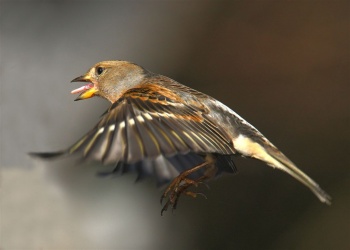- Fringilla montifringilla
Identification
13·5–16 cm (5¼-6¼ in)
Male
Breeding
- Glossy bluish-black head, nape, shoulders and mantle
- Orange breast and wing patch
- White belly
- Black and white wings
- White rump
- Black bill
Non-breeding
- Black upperparts are speckled and duller
- Yellow bill
Female: similar to winter male, but with a grey crown
Juvenile: the white rump has a yellow tinge,
Similar Species
Chaffinch: male has a grey head, nape and bill. Green rump.
Distribution
Breeds throughout Norway and in all but southernmost parts of Sweden and Finland, in Estonia and across northern Russia east to the Urals. An isolated population breeds in the Alps in northern Italy and has bred in Iceland, north-central Scotland, Netherlands, Germany and Denmark.
A migratory species with autumn passage mainly in mid-September to October, sometimes November with most birds moving south or south-west through Europe. Widespread in winter throughout Europe south of breeding range occurring west to Iberia and south to the Mediterranean, Turkey and the Middle East. Return passage takes place in March-mid May.
Vagrants recorded in Iceland and Faroes and has bred in both, also recorded in the Canaries, Madeira, Cyprus and North Africa, Jordan and Iraq.
Taxonomy
This is a monotypic species[1].
Habitat
Breeds in open coniferous forest, birch woodland and riverine willows and winters along woodland edges close to open farmland and especially stubble fields. In some areas large numbers gather in autumn and winter in beech woods to feed on beech mast, also fond of hornbeam seeds.
Behaviour
In winter usually found in large mixed flocks with other finches mostly feeding in stubble fields lined with trees and bushes. They will visit garden feeders, especially in hard weather.
Flight is very similar to Chaffinch.
Breeding
Monogamous. The female builds the cup shaped nest, in the fork of a birch (sometimes a spruce) tree, from moss, grass, bark, lichen and hair, lining it with feathers and wool. The clutch generally consists of around 5-7 eggs which are shiny, greenish through to brownish with dark brown markings which are incubated by the female for 11-12 days. The young are fed by both adults and fledge after 11-13 days. There may be a second brood in Siberia and Russia.
Diet
Their diet consists of seeds, fruit and, during the breeding season small insects and their larvae. In the winter they are particularly fond of beech mast.
Vocalisation
Listen to Brambling voice clip
References
- Clements, J. F., P. C. Rasmussen, T. S. Schulenberg, M. J. Iliff, T. A. Fredericks, J. A. Gerbracht, D. Lepage, A. Spencer, S. M. Billerman, B. L. Sullivan, M. Smith, and C. L. Wood. 2024. The eBird/Clements checklist of Birds of the World: v2024. Downloaded from https://www.birds.cornell.edu/clementschecklist/download/
- British Garden Birds
- Brazil, M. (2009). Birds of East Asia. Princeton Univ. Press.
- Clement, P. & Arkhipov, V. (2017). Brambling (Fringilla montifringilla). In: del Hoyo, J., Elliott, A., Sargatal, J., Christie, D.A. & de Juana, E. (eds.). Handbook of the Birds of the World Alive. Lynx Edicions, Barcelona. (retrieved from http://www.hbw.com/node/61288 on 30 June 2017 and September 2018).
- Clement, P., A. Harris, and J. Davis. 1993. Finches and Sparrows: An Identification Guide. Princeton Univ. Press, Princeton, N. J.
- Collins Bird Guide ISBN 0 00 219728 6
Recommended Citation
- BirdForum Opus contributors. (2025) Brambling. In: BirdForum, the forum for wild birds and birding. Retrieved 13 May 2025 from https://www.birdforum.net/opus/Brambling
External Links
GSearch checked for 2020 platform.1








